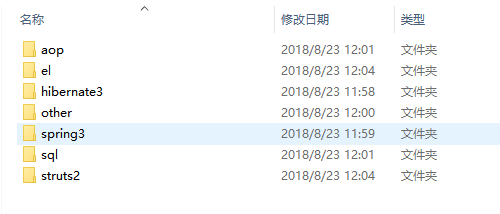相關jar包分享:struts2+hibernate3+spring3 以及aop ,mysql,以及整合必須包。 鏈接:https://pan.baidu.com/s/1nCHmSsKU0hiV8DTj_V03sQ 密碼:29nf 在學習spring和hibernate的基礎後,試著將三大框架整合 ...
相關jar包分享:struts2+hibernate3+spring3 以及aop ,mysql,以及整合必須包。
鏈接:https://pan.baidu.com/s/1nCHmSsKU0hiV8DTj_V03sQ 密碼:29nf

在學習spring和hibernate的基礎後,試著將三大框架整合,下麵以登陸為例,作為學習筆記供初學者參考。
總結一下思路:
第一步:從客戶端獲取用戶輸入數據,即用戶名和密碼,然後交給action處理。
第二步:action需要使用service介面提供的功能,如登陸,註冊,修改信息等,並返回執行結果,然後給用戶響應。
第三步:service層負責業務邏輯,通過dao介面來增刪改查資料庫中多個表的數據,從而完成一個功能,實際應用中不可能像登陸這麼簡單。
第四步:hibernate完成了實體類持久化,所有dao層負責對model層實體類的管理,即實現了對錶數據的管理。
另外使用了事物管理器,使事物的管理更加規範,代碼也更加簡潔,這裡不做介紹,可以參考其他文章。
web.xml配置代碼:
註:其中這裡applicationContext.xml放在src目錄下,需用classpath指明。(系統預設的applicationContext.xml文件是在WEB-INF下)
<!-- 配置Spring的核心監聽器 --> <listener> <listener-class>org.springframework.web.context.ContextLoaderListener</listener-class> </listener> <context-param> <param-name>contextConfigLocation</param-name> <param-value>classpath:applicationContext.xml</param-value> </context-param> <!-- 配置structs2 --> <filter> <filter-name>Struts2</filter-name> <filter-class> org.apache.struts2.dispatcher.ng.filter.StrutsPrepareAndExecuteFilter </filter-class> </filter> <filter-mapping> <filter-name>Struts2</filter-name> <url-pattern>*.do</url-pattern> </filter-mapping>
login.jsp代碼:
<form method="post" onsubmit="return loginCheck()" id="loginForm"> <div> <input type="text" id="name"/> </div> <div> <input type="password" id="pass"/> </div> <button id="submit" type="submit">登 錄</button> </form>
在這裡並沒有用action="login.do"的方式提交表單,而是使用ajax非同步請求,讀者若不理解可以使用傳統的方式,下麵做簡單的介紹:
格式:$.ajax({type:'',data:'',async:''...})
參數:
cache: true緩存頁面 false不緩存頁面
type:get/post
data:發送到伺服器的數據,必須為Object/String類型,對象必須為key/value格式
dataType:想要伺服器返回數據的類型
success:(data,textStatus,jqXHR):請求成功後的回調函數。參數:由伺服器返回,並根據dataType參數進行處理後的數據;描述狀態的字元串。還有 jqXHR(在jQuery 1.4.x的中,XMLHttpRequest) 對象 。在jQuery 1.5, 成功設置可以接受一個函數數組。每個函數將被依次調用。
點擊登陸按鈕執行loginCheck()函數,代碼如下:
//登陸按鈕事件 function loginCheck(){ $.ajax({ url:"${pageContext.request.contextPath}/wp/login.do", data:{ username:function(){ return $("#name").val();//註:用id為name的值賦值給username(對應Action屬性里的username) }, password:function(){ return $("#pass").val(); } }, dataType:"json", cache:false, type:"POST", success:function(data){ if(data =='ok'){ alert("登陸成功!"); } else{ alert("登陸失敗!"); } }, }); return false; }
loginAction代碼:
public class loginAction extends ActionSupport{ private String username; private String password; private UserService userService;//業務邏輯層的介面
private User user;
public String checkresult;//判斷結果,以json的方式傳給ajax
public UserService getUserService() { return userService; } public void setUserService(UserService userService){ this.userService = userService; } public User getUser() { return user; } public void setUser(User user) { this.user = user; } public String login(){ this.user=userService.getUserByLoginname(username); if(user!=null&&user.getPassword().equals(password)){ //System.out.println("success"); ActionContext actionContext=ActionContext.getContext(); actionContext.getSession().put("user", user); this.checkresult = "ok"; }else{ this.checkresult ="err"; } return SUCCESS; } public String getUsername() { return username; } public void setUsername(String username) { this.username = username; } public String getPassword() { return password; } public void setPassword(String password) { this.password = password; } public String getcheckresult() { return this.checkresult; } }
struts.xml代碼:
<package name="user" namespace="/" extends="json-default"> <action name="login" class="loginAction" method="login"> <result type="json"> <param name="root">checkresult</param> </result> </action>
</package>
以上已經完成表現層的設計,下麵我們要具體的設計業務邏輯層和數據訪問層,在這之前我們要先說明下各個文件的放置位置。
首先我們在包目錄:com.標識公司名.項目名.模塊名
下再分別建sevice,dao,action,model四個包,service和dao中新建Impl放介面的實現,一個模塊的包結構如下圖。

applicationContent.xml代碼:
<?xml version="1.0" encoding="UTF-8"?> <beans xmlns="http://www.springframework.org/schema/beans" xmlns:xsi="http://www.w3.org/2001/XMLSchema-instance" xmlns:p="http://www.springframework.org/schema/p" xmlns:util="http://www.springframework.org/schema/util" xmlns:context="http://www.springframework.org/schema/context" xmlns:aop="http://www.springframework.org/schema/aop" xmlns:tx="http://www.springframework.org/schema/tx" xsi:schemaLocation="http://www.springframework.org/schema/beans http://www.springframework.org/schema/beans/spring-beans.xsd http://www.springframework.org/schema/util http://www.springframework.org/schema/util/spring-util.xsd http://www.springframework.org/schema/aop http://www.springframework.org/schema/aop/spring-aop.xsd http://www.springframework.org/schema/context http://www.springframework.org/schema/context/spring-context.xsd http://www.springframework.org/schema/tx http://www.springframework.org/schema/tx/spring-tx.xsd" default-lazy-init ="true"> <bean id="sessionFactory" class="org.springframework.orm.hibernate3.annotation.AnnotationSessionFactoryBean"> <property name="configLocation" value="classpath:hibernate.cfg.xml" /> </bean> <!-- 配置事務管理器 --> <bean id="transactionManager" class="org.springframework.orm.hibernate3.HibernateTransactionManager"> <property name="sessionFactory" ref="sessionFactory" /> </bean> <!-- 啟用事務註解掃描 --> <tx:annotation-driven transaction-manager="transactionManager"/>
<!-- User --> <bean id="user" class="com.user.model.User" lazy-init="false"></bean> <!--UserDaoImpl--> <bean id="userDAO" class="com.user.dao.impl.UserDaoImpl"> <property name="sessionFactory"> <ref bean="sessionFactory" /> </property> </bean> <!--UserServiceImpl--> <bean id="userService" class="com.user.service.impl.UserServiceImpl"> <property name="userDAO" ref="userDAO"/> </bean> <!--loginAction--> <bean id="loginAction" class="com.user.action.loginAction" scope="prototype"> <property name="userService" ref="userService"/> <property name="user" ref="user"/> </bean>
</beans>
hibernate.cfg.xml :配置資料庫的連接池,以及.hbm.xml文件的映射。
<?xml version="1.0" encoding="UTF-8"?> <!DOCTYPE hibernate-configuration PUBLIC "-//Hibernate/Hibernate Configuration DTD//EN" "http://hibernate.sourceforge.net/hibernate-configuration-3.0.dtd"> <hibernate-configuration> <session-factory> <property name="hibernate.bytecode.use_reflection_optimizer">false</property> <property name="hibernate.connection.driver_class">com.mysql.jdbc.Driver</property> <property name="hibernate.connection.password">123456</property> <property name="hibernate.connection.url">jdbc:mysql://localhost:3306/wp</property> <property name="hibernate.connection.username">root</property> <property name="hibernate.dialect">org.hibernate.dialect.MySQLDialect</property> <property name="hibernate.show_sql">true</property> <mapping resource="com/user/model/User.hbm.xml"/> </session-factory> </hibernate-configuration>
User-hbm.xml 和User類放在model包下 :xml文件配置與User類的映射,註意與User類的對應,熟悉後可使用工具直接從資料庫生成。
資料庫user表有三個屬性:id,loginname,password
<?xml version="1.0"?> <!DOCTYPE hibernate-mapping PUBLIC "-//Hibernate/Hibernate Mapping DTD 3.0//EN" "http://hibernate.sourceforge.net/hibernate-mapping-3.0.dtd"> <hibernate-mapping> <class name="com.user.model.User" table="user" catalog="wp"> <id name="id" type="long"> <column name="id" /> <generator class="identity" /> </id> <property name="loginName" type="string"> <column name="loginName" length="50" not-null="true" /> </property> <property name="password" type="string"> <column name="password" length="50" not-null="true" /> </property> </class> </hibernate-mapping>
User類:
public class User { private long id; private String loginName; private String password; public User() { } public User(long id, String loginName, String password) { this.id = id; this.loginName = loginName; this.password = password; } public long getId() { return this.id; } public void setId(long id) { this.id = id; } public String getLoginName() { return this.loginName; } public void setLoginName(String loginName) { this.loginName = loginName; } public String getPassword() { return this.password; } public void setPassword(String password) { this.password = password; } }
UserService介面放在sevice包中,如下所示。
public interface UserService { public User getUserByLoginname(String username);// 判斷用戶名是否存在 public boolean save(User user);//註冊 public boolean modifyUser(User newuser);//修改用戶信息 public boolean updatePass(Long id,String newPassword);//修改密碼 }
UserServiceImpl實現了 UserService介面,放在sevice.impl包中。
public class UserServiceImpl implements UserService{ private UserDao userDao; public UserDao getUserDAO(){ return userDAO; } public void setUserDAO(UserDao userDAO) { this.userDAO = userDAO; } public User getUserByLoginname(String username){ User user= userDAO.findByLoginname(username); if(user!=null){ return user; } else return null; } public boolean save(User user){ return userDAO.save(user); } @Override public boolean modifyUser(User newuser) { // TODO Auto-generated method stub return false; } @Override public boolean updatePass(Long id, String newPassword) { // TODO Auto-generated method stub return false; } }
UserDao介面放在dao包中, UserDaoImpl實現介面,放在dao.impl中。
public interface UserDao { public boolean save(User user) ; public User getById(Long id); public User findByLoginname(String username); public boolean updateUser(User user); public boolean updateUser(User user,String newpassword); }
@Transactional//事物註解
public class UserDaoImpl implements UserDao {
private SessionFactory sessionFactory; public SessionFactory getSessionFactory() { return sessionFactory; } public void setSessionFactory(SessionFactory sessionFactory) { this.sessionFactory = sessionFactory; } @Override public boolean save(User user) { Session session= sessionFactory.getCurrentSession(); try{ session.save(user); }catch(HibernateException e){ return false; } return true; } @Override public User getById(Long id) { Session session = sessionFactory.getCurrentSession(); User user=null; user=(User)session.get(User.class,id); return user; } @Override public User findByLoginname(String username) { List<User> users=findByProperty("loginName",username); if(users!=null&&users.size()==1) return users.get(0); return null; } public List<User> findByProperty(String PropertyName,Object value){ Session session =sessionFactory.getCurrentSession(); List<User> users=null; Criteria cr = session.createCriteria(User.class); cr.add(Restrictions.eq(PropertyName,value)); users=cr.list(); return users; } @Override public boolean updateUser(User user) { // TODO Auto-generated method stub return false; } @Override public boolean updateUser(User user, String newpassword) { // TODO Auto-generated method stub return false; } }



